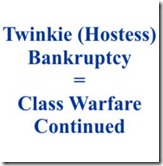
While the attempt is to blame unions for having several different working rules and benefits the fact that other businesses can operate profitably speaks of the likely incompetence of Hostess’ management, the management that believe themselves deserving of raises.
But I digress. It is time for us to examine worth. We have in our society those that managers and capital manipulators that we tend to give reverence to or accept that they are deserving of the income they receive. We must change our mindset. They managed Hostess but the middle class workers made it the company it use to be. It is the changes instituted by the managers, the deals made by the titans of capital that put the company at risk. Yet as usual they want workers to bare the brunt their error.
Even in the bankruptcy of Hostess, the titans of finance are likely to come out ahead as they sell off assets. And the middle class working will be left holding the bag.
The American middle class worker must reassert themselves. In doing so they must know within their soul that the worth of the guys in the head office is not more than their own worth. When one no longer worships management or those they perceive as more worthy, they will have the necessary clarity of mind to demand what is theirs and stop those above from pilfering them. To end class warfare you must win not only little battles but the war.
This is a story that repeats itself over and over again. I wrote the book “As I See It: Class Warfare The Only Resort To Right Wing Doom” that described many of these problems that are killing the middle class and to empower folks with the knowledge that will be necessary to fight it. The battle is more effectively fought if we know not only what the problems are, but how and why they came about and how they are best solved.
I like Paul Krugman’s segue on the Twinkie fiasco below.
LIKE My Facebook Page
Follow @EgbertoWillies
Op-Ed Columnist
The Twinkie Manifesto
By PAUL KRUGMAN Published: November 18, 2012
The Twinkie, it turns out, was introduced way back in 1930. In our memories, however, the iconic snack will forever be identified with the 1950s, when Hostess popularized the brand by sponsoring “The Howdy Doody Show.” And the demise of Hostess has unleashed a wave of baby boomer nostalgia for a seemingly more innocent time. Needless to say, it wasn’t really innocent. But the ’50s — the Twinkie Era — do offer lessons that remain relevant in the 21st century. Above all, the success of the postwar American economy demonstrates that, contrary to today’s conservative orthodoxy, you can have prosperity without demeaning workers and coddling the rich.
Consider the question of tax rates on the wealthy. The modern American right, and much of the alleged center, is obsessed with the notion that low tax rates at the top are essential to growth. Remember that Erskine Bowles and Alan Simpson, charged with producing a plan to curb deficits, nonetheless somehow ended up listing “lower tax rates” as a “guiding principle.”
Yet in the 1950s incomes in the top bracket faced a marginal tax rate of 91, that’s right, 91 percent, while taxes on corporate profits were twice as large, relative to national income, as in recent years. The best estimates suggest that circa 1960 the top 0.01 percent of Americans paid an effective federal tax rate of more than 70 percent, twice what they pay today.
Nor were high taxes the only burden wealthy businessmen had to bear. They also faced a labor force with a degree of bargaining power hard to imagine today. In 1955 roughly a third of American workers were union members. In the biggest companies, management and labor bargained as equals, so much so that it was common to talk about corporations serving an array of “stakeholders” as opposed to merely serving stockholders.
Squeezed between high taxes and empowered workers, executives were relatively impoverished by the standards of either earlier or later generations. In 1955 Fortune magazine published an essay, “How top executives live,” which emphasized how modest their lifestyles had become compared with days of yore. The vast mansions, armies of servants, and huge yachts of the 1920s were no more; by 1955 the typical executive, Fortune claimed, lived in a smallish suburban house, relied on part-time help and skippered his own relatively small boat.
The data confirm Fortune’s impressions. Between the 1920s and the 1950s real incomes for the richest Americans fell sharply, not just compared with the middle class but in absolute terms. According to estimates by the economists Thomas Piketty and Emmanuel Saez, in 1955 the real incomes of the top 0.01 percent of Americans were less than half what they had been in the late 1920s, and their share of total income was down by three-quarters.
Today, of course, the mansions, armies of servants and yachts are back, bigger than ever — and any hint of policies that might crimp plutocrats’ style is met with cries of “socialism.” Indeed, the whole Romney campaign was based on the premise that President Obama’s threat to modestly raise taxes on top incomes, plus his temerity in suggesting that some bankers had behaved badly, were crippling the economy. Surely, then, the far less plutocrat-friendly environment of the 1950s must have been an economic disaster, right?


